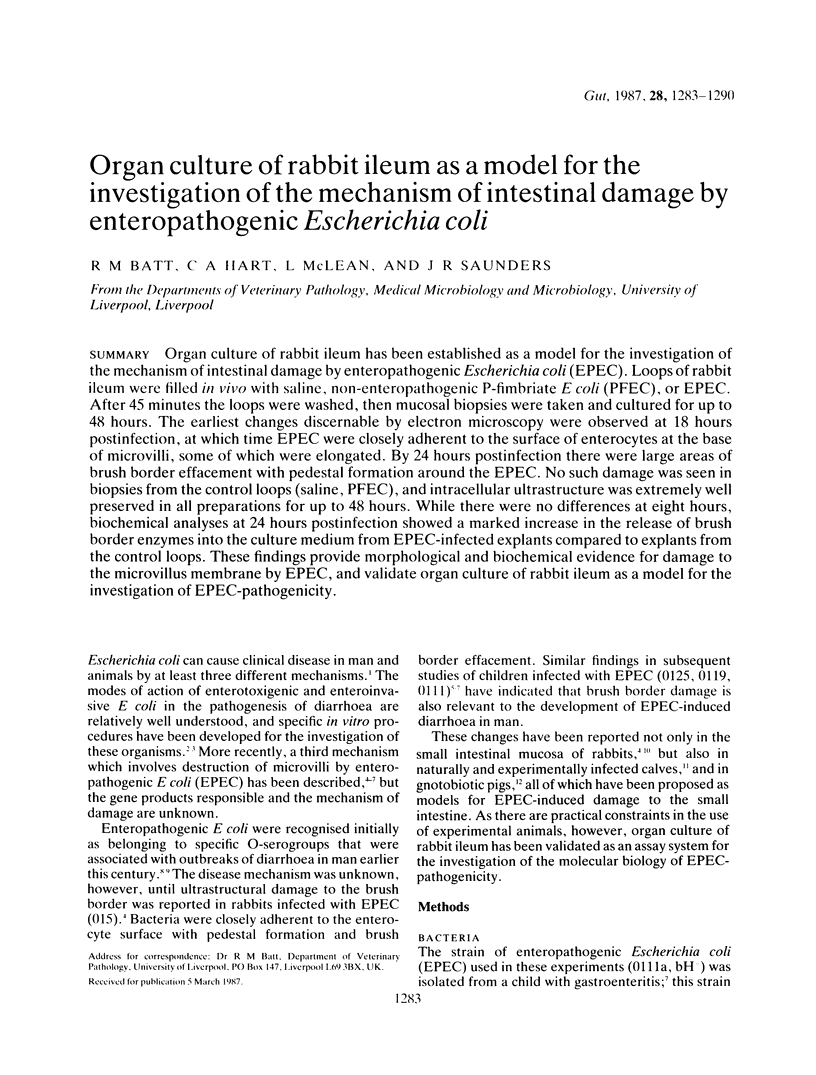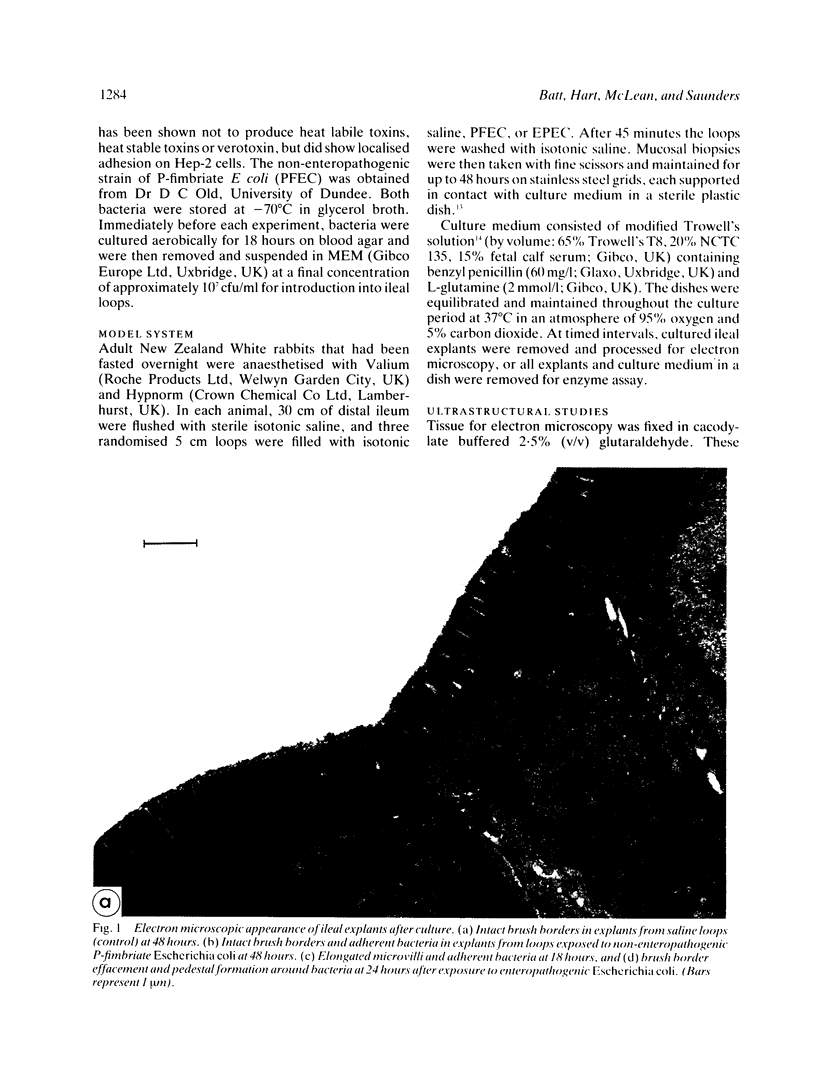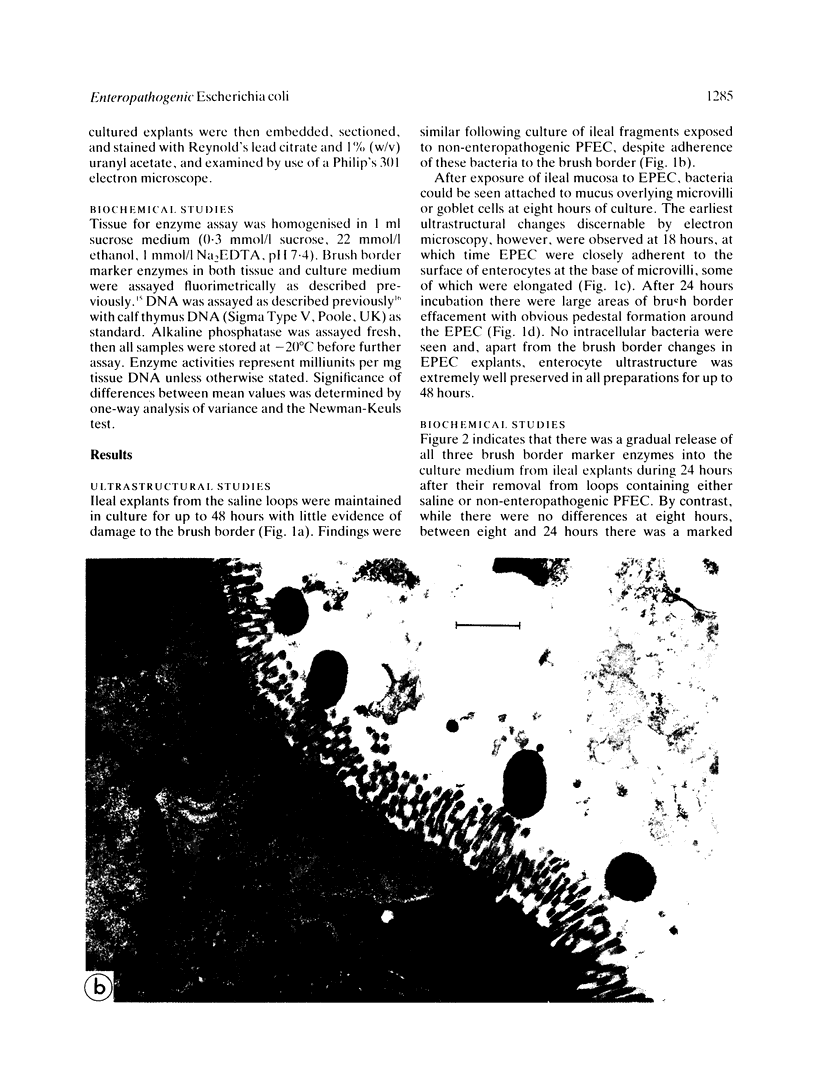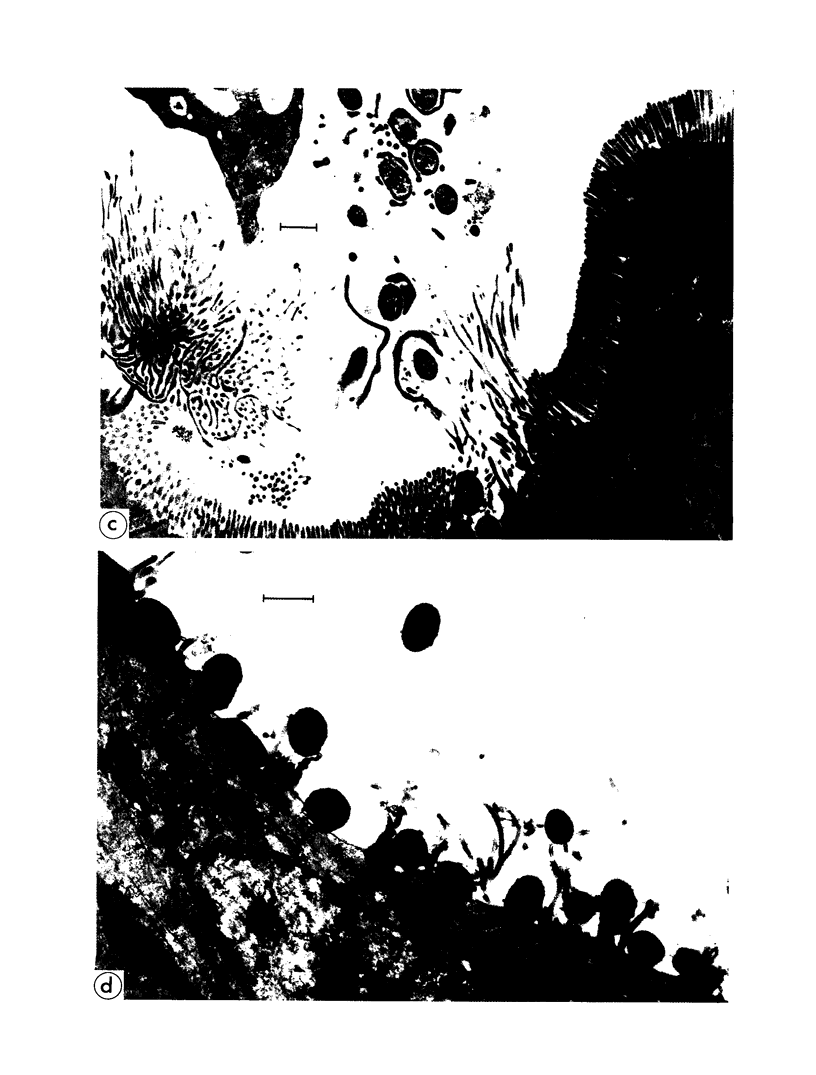Abstract
Organ culture of rabbit ileum has been established as a model for the investigation of the mechanism of intestinal damage by enteropathogenic Escherichia coli (EPEC). Loops of rabbit ileum were filled in vivo with saline, non-enteropathogenic P-fimbriate E coli (PFEC), or EPEC. After 45 minutes the loops were washed, then mucosal biopsies were taken and cultured for up to 48 hours. The earliest changes discernable by electron microscopy were observed at 18 hours postinfection, at which time EPEC were closely adherent to the surface of enterocytes at the base of microvilli, some of which were elongated. By 24 hours postinfection there were large areas of brush border effacement with pedestal formation around the EPEC. No such damage was seen in biopsies from the control loops (saline, PFEC), and intracellular ultrastructure was extremely well preserved in all preparations for up to 48 hours. While there were no differences at eight hours, biochemical analyses at 24 hours postinfection showed a marked increase in the release of brush border enzymes into the culture medium from EPEC-infected explants compared to explants from the control loops. These findings provide morphological and biochemical evidence for damage to the microvillus membrane by EPEC, and validate organ culture of rabbit ileum as a model for the investigation of EPEC-pathogenicity.
Full text
PDF







Images in this article
Selected References
These references are in PubMed. This may not be the complete list of references from this article.
- Batt R. M., Peters T. J. Subcellular fractionation studies on peroral jejunal biopsies from the dog. Res Vet Sci. 1978 Jul;25(1):94–100. [PubMed] [Google Scholar]
- Browning T. H., Trier J. S. Organ culture of mucosal biopsies of human small intestine. J Clin Invest. 1969 Aug;48(8):1423–1432. doi: 10.1172/JCI106108. [DOI] [PMC free article] [PubMed] [Google Scholar]
- Candy D. C., McNeish A. S. Human Escherichia coli diarrhoea. Arch Dis Child. 1984 May;59(5):395–396. doi: 10.1136/adc.59.5.395. [DOI] [PMC free article] [PubMed] [Google Scholar]
- Cantey J. R., Blake R. K. Diarrhea due to Escherichia coli in the rabbit: a novel mechanism. J Infect Dis. 1977 Mar;135(3):454–462. doi: 10.1093/infdis/135.3.454. [DOI] [PubMed] [Google Scholar]
- Dean A. G., Ching Y. C., Williams R. G., Harden L. B. Test for Escherichia coli enterotoxin using infant mice: application in a study of diarrhea in children in Honolulu. J Infect Dis. 1972 Apr;125(4):407–411. doi: 10.1093/infdis/125.4.407. [DOI] [PubMed] [Google Scholar]
- Edelman R., Levine M. M. From the National Institute of Allergy and Infectious Diseases. Summary of a workshop on enteropathogenic Escherichia coli. J Infect Dis. 1983 Jun;147(6):1108–1118. doi: 10.1093/infdis/147.6.1108. [DOI] [PubMed] [Google Scholar]
- Hall G. A., Reynolds D. J., Chanter N., Morgan J. H., Parsons K. R., Debney T. G., Bland A. P., Bridger J. C. Dysentery caused by Escherichia coli (S102-9) in calves: natural and experimental disease. Vet Pathol. 1985 Mar;22(2):156–163. doi: 10.1177/030098588502200210. [DOI] [PubMed] [Google Scholar]
- Jos J., Lenoir G., Ritis G D., Rey J. In vitro pathogenetic studies of coeliac disease. Effects of protein digests on coeliac intestinal biopsy specimens maintained in culture for 48 hours. Scand J Gastroenterol. 1975;10(2):121–128. [PubMed] [Google Scholar]
- Labarca C., Paigen K. A simple, rapid, and sensitive DNA assay procedure. Anal Biochem. 1980 Mar 1;102(2):344–352. doi: 10.1016/0003-2697(80)90165-7. [DOI] [PubMed] [Google Scholar]
- NETER E. Enteritis due to enteropathogenic Escherichia coli; present-day status and unsolved problems. J Pediatr. 1959 Aug;55(2):223–239. doi: 10.1016/s0022-3476(59)80091-3. [DOI] [PubMed] [Google Scholar]
- Peeters J. E., Charlier G. J., Halen P. H. Pathogenicity of attaching effacing enteropathogenic Escherichia coli isolated from diarrheic suckling and weanling rabbits for newborn rabbits. Infect Immun. 1984 Dec;46(3):690–696. doi: 10.1128/iai.46.3.690-696.1984. [DOI] [PMC free article] [PubMed] [Google Scholar]
- Rothbaum R., McAdams A. J., Giannella R., Partin J. C. A clinicopathologic study of enterocyte-adherent Escherichia coli: a cause of protracted diarrhea in infants. Gastroenterology. 1982 Aug;83(2):441–454. [PubMed] [Google Scholar]
- SERENY B. Experimental shigella keratoconjunctivitis; a preliminary report. Acta Microbiol Acad Sci Hung. 1955;2(3):293–296. [PubMed] [Google Scholar]
- Scott J., Peters T. J. Protection of epithelial function in human jejunum cultured with hydrocortisone. Am J Physiol. 1983 May;244(5):G532–G540. doi: 10.1152/ajpgi.1983.244.5.G532. [DOI] [PubMed] [Google Scholar]
- Taylor C. J., Hart A., Batt R. M., McDougall C., McLean L. Ultrastructural and biochemical changes in human jejunal mucosa associated with enteropathogenic Escherichia coli (0111) infection. J Pediatr Gastroenterol Nutr. 1986 Jan;5(1):70–73. doi: 10.1097/00005176-198601000-00013. [DOI] [PubMed] [Google Scholar]
- Tzipori S., Robins-Browne R. M., Gonis G., Hayes J., Withers M., McCartney E. Enteropathogenic Escherichia coli enteritis: evaluation of the gnotobiotic piglet as a model of human infection. Gut. 1985 Jun;26(6):570–578. doi: 10.1136/gut.26.6.570. [DOI] [PMC free article] [PubMed] [Google Scholar]
- Ulshen M. H., Rollo J. L. Pathogenesis of escherichia coli gastroenteritis in man--another mechanism. N Engl J Med. 1980 Jan 10;302(2):99–101. doi: 10.1056/NEJM198001103020207. [DOI] [PubMed] [Google Scholar]





